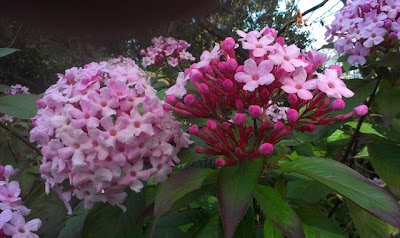The delightfully fragrant luculia is very, very pleasing as well as distylous
Hard to miss this one if you enter Melbourne's Royal Botanic Gardens through our otherwise underwhelming Gate A, near where Anderson Street meets the Yarra River. Look out for the big pink bouquets, and waft of heady perfume. Luculia gratissima was also a stand out during last weekend's Open Day at Burnley Gardens.
As John Patrick from Gardening Australia notes, gratissima is Latin for very, very pleasing. The bestower of the botanical name, the aptly named Robert Sweet (a bit like Mr Grey's grey plant, my next victim...), sums up the species as the delightfully fragrant luculia.
This painting from that original publication was based on fresh specimens sent to Mr Sweet by the Countess of Bridgewater, who had grown the plant in her conservatory in Ashridge since 1816. Sweet cannot recollect having met with any flower of a more agreeable perfume, and one that remains so long in the dried specimen.
The genus Luculia was described by Sweet in 1826 from specimens collected by Dr Nathaniel Wallich in Nepal. In the explicatorily titled volume "The British Flower Garden (Series the Second), containing coloured figures and descriptions of the most ornamental and curious hardy flowering plants; or those that are somewhat tender, but may still be cultivated in a warm border, needing only a mat, or a garden pot, placed over them in severe frost; some will even require both expedients", Sweet says that Dr Wallich found [and presumably smelt] our luculia growing on exposed hills and flowering year round. In Ashridge, according to the Countess' gardener Mr Poynter, it bloomed from October to the end of January (mid autumn to mid winter).
Modern accounts describe the flowering season in its natural habitat as August to December, and its natural habitat as on the southeast margin of the Tibetan Plateau in south-west China and adjacent region of Nepal and Myanmar.
Sweet gives a number of earlier names such as Cinchona gratissima and Mussaenda gratissima, as well as the local common names of Luculi Swa and Lechoni Swa, clearly his inspiration for the genus name Luculia.
Botanists find this species, and its four other relatives in Luculia, interesting because there are two different floral designs, one with the female receptive area extended further away from the base of the flower and therefore above rather than below the male bits. Called reciprocal placement, the female and male bits remain the same distance apart but swapped around (i.e. the female column is the same distance above, or below, the male bits).
Biologists right back to that chap called Charles Darwin have interpreted this as providing a neat way for a pollinating bug or bird to stick its head (or some part) into a flower so that it can both collect and deliver pollen at the same place. This ploy is used by a few plants scattered across the evolutionary tree and it's said to reduce the chance of the plant pollinating itself - it's better for the long term viability of the species to be mixing up the genes a bit as time goes on.
There is some debate about whether this really is the reason for the two kinds of flowers and some recent work has show that many plants with this distyly (two kinds of style, a style being the female bit) don't have the nice reciprocity. There are also varying degrees to which the flowers differ in other respects in correlation with distyly, such as in their size and shape. It's said the flowers of Luculia gratissima with shorter female stalks (styles) are generally larger in size.
So I returned to the garden, this time to a pair of Luculia near one of our more elegant entrances, D Gate. They seem to be Luculia gratissima, separated by a Luculia grandiflora which has finished flowering. As luck would have it the flowers on one of the plants have styles sticking out from the floral tube while those of the other are like the A Gate plant and have them hidden within. I am pleased to confirm that the petals of the flowers with shorter styles are larger. Here they are: plant one flowers with style sticking out and smaller petals, plant two flowers with stamens visible and larger petals.
Less convincing was the reciprocal placement. The sticky-out styles seemed to be further away from the stamens than the short ones . But then maybe the changes in flower shape alter the relative position if you are a bug sticking your head into the floral tube (the stamens in the top picture do seem to be further down the tube)?
It looks to me, and to one of our botanists Neville Walsh, as if the settings on these flowers would allow self-pollinating in the bottom architecture (where the pollen can simply drop onto the style) and cross-pollinating in the top one (the style is the first thing a pollinator would hit after visiting one of the other flower type). The best of both worlds in terms of short-term seed production and long-term mixing up of genes?
From a scientific perspective moderately pleasing, but aesthetically very, very much more so.
Images: Except for the last two, my pictures are from Burnley Gardens.






Comments